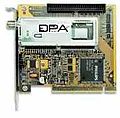- DPandA DVB-T PCI Digital TV Receiver Card For The PC
-
The DPandA DVB-T PCI Digital TV Card is notable because it was the first Digital Terrestrial TV card for the PC to be available in Australia. The card was launched in June 2003 by David Porter & Associates Pty Ltd. (DPandA), an IT and Digital Technology company based in Sydney and Brisbane.
DPandA partnered with German company TechnoTrend to offer their Budget T-1300 and T-1500 Digital TV cards in an OEM agreement under the DPandA brand.
At the time of the launch of the DPandA DVB-T PCI Card, Australia was one of the first countries to transmit High Definition Digital Television Signals (HDTV) using the PAL based DVB-T (Digital Video Broadcasting – Terrestrial) format.
Development of the card in Germany up until this time had been focused on Standard Definition Digital Television (SDTV).
On its release, the DPandA DVB-T PCI card could only decode Standard Definition Digital Television signals. Due to the DPandA card using software based MPEG2 encoders/decoders (codecs) the modifications were complete within a month of the card’s launch. The new software drivers provided full support for the reception of High Definition digital television broadcasts.
DPandA DVB-T PCI card is also notable because it was the first card to bring Digital Television to the Apple Macintosh in Australia and was one of the earliest Digital TV cards to work under Linux. Within a month of the DPandA card being launched in Australia, an independent Sydney-based software engineer produced Macintosh drivers, helped by work that had been done by the Linux community. The card was used in conjunction with the developers iTele application, for viewing the Digital TV Stream on the Macintosh.
The card was primarily released for use with Windows 98 but has had driver support up to, and including, Windows 7.
References
External links
Categories:- Digital terrestrial television in Australia
- Digital video recorders
Wikimedia Foundation. 2010.

